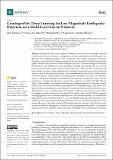| dc.contributor.author | Shaheen, Ahmed | |
| dc.contributor.author | Waheed, Umair bin | |
| dc.contributor.author | Fehler, Michael | |
| dc.contributor.author | Sokol, Lubos | |
| dc.contributor.author | Hanafy, Sherif | |
| dc.date.accessioned | 2021-12-09T20:20:45Z | |
| dc.date.available | 2021-12-09T20:20:45Z | |
| dc.date.issued | 2021-12-02 | |
| dc.identifier.uri | https://hdl.handle.net/1721.1/138413 | |
| dc.description.abstract | Automatic detection of low-magnitude earthquakes has become an increasingly important research topic in recent years due to a sharp increase in induced seismicity around the globe. The detection of low-magnitude seismic events is essential for microseismic monitoring of hydraulic fracturing, carbon capture and storage, and geothermal operations for hazard detection and mitigation. Moreover, the detection of micro-earthquakes is crucial to understanding the underlying mechanisms of larger earthquakes. Various algorithms, including deep learning methods, have been proposed over the years to detect such low-magnitude events. However, there is still a need for improving the robustness of these methods in discriminating between local sources of noise and weak seismic events. In this study, we propose a convolutional neural network (CNN) to detect seismic events from shallow borehole stations in Groningen, the Netherlands. We train a CNN model to detect low-magnitude earthquakes, harnessing the multi-level sensor configuration of the G-network in Groningen. Each G-network station consists of four geophones at depths of 50, 100, 150, and 200 m. Unlike prior deep learning approaches that use 3-component seismic records only at a single sensor level, we use records from the entire borehole as one training example. This allows us to train the CNN model using moveout patterns of the energy traveling across the borehole sensors to discriminate between events originating in the subsurface and local noise arriving from the surface. We compare the prediction accuracy of our trained CNN model to that of the STA/LTA and template matching algorithms on a two-month continuous record. We demonstrate that the CNN model shows significantly better performance than STA/LTA and template matching in detecting new events missing from the catalog and minimizing false detections. Moreover, we find that using the moveout feature allows us to effectively train our CNN model using only a fraction of the data that would be needed otherwise, saving plenty of manual labor in preparing training labels. The proposed approach can be easily applied to other microseismic monitoring networks with multi-level sensors. | en_US |
| dc.publisher | Multidisciplinary Digital Publishing Institute | en_US |
| dc.relation.isversionof | http://dx.doi.org/10.3390/s21238080 | en_US |
| dc.rights | Creative Commons Attribution | en_US |
| dc.rights.uri | https://creativecommons.org/licenses/by/4.0/ | en_US |
| dc.source | Multidisciplinary Digital Publishing Institute | en_US |
| dc.title | GroningenNet: Deep Learning for Low-Magnitude Earthquake Detection on a Multi-Level Sensor Network | en_US |
| dc.type | Article | en_US |
| dc.identifier.citation | Sensors 21 (23): 8080 (2021) | en_US |
| dc.contributor.department | Massachusetts Institute of Technology. Department of Earth, Atmospheric, and Planetary Sciences | |
| dc.contributor.department | Massachusetts Institute of Technology. Earth Resources Laboratory | |
| dc.identifier.mitlicense | PUBLISHER_CC | |
| dc.eprint.version | Final published version | en_US |
| dc.type.uri | http://purl.org/eprint/type/JournalArticle | en_US |
| eprint.status | http://purl.org/eprint/status/PeerReviewed | en_US |
| dc.date.updated | 2021-12-09T14:32:18Z | |
| dspace.date.submission | 2021-12-09T14:32:18Z | |
| mit.license | PUBLISHER_CC | |
| mit.metadata.status | Authority Work and Publication Information Needed | en_US |
